It can be said that sculpture and fashion can be easily linked. Distill the two disciplines down to their essential form and one finds the occupying of space and commenting upon present day aesthetics to be two apparent intersections. A young Chicago artist, Erin Smego, is investigating this frequently overlooked territory through the production of minimalist inspired installations and inexplainable allusions through her utilization of beauty application tools, spray paint, raw lumber and other contemporary accessories. This week the COMP Magazine headed up to Hermosa on Chicago’s northwest side to discuss with Smego her process of selecting materials that reflect her conceptual concerns, the fabrication of the Lumber Drawing series, her musing on the absurdity that can be revealed in art, and what she presently values most in her creative explorations.
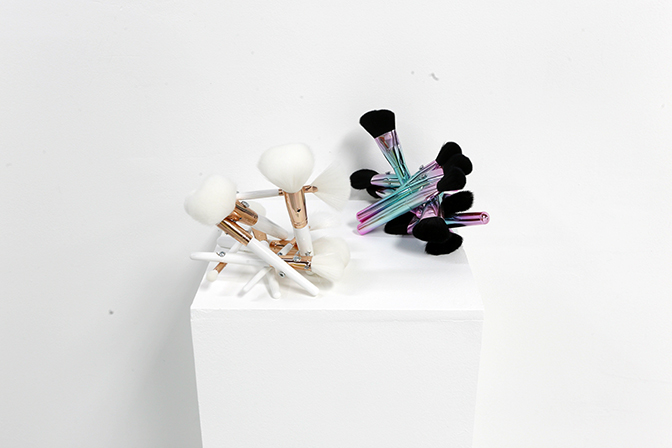
photograph by Boris Ostrerov
You grew up in Chicagoland, down south in New Lenox, studied at SAIC, and have been focused on developing a professional practice since 2011. Lets step slightly back and discuss early identifiers that you see as influential in setting you on your aesthetic investigations. Were there any specific events or people who prompted this interest?
Both of my parents worked full-time, so I spent a lot of time by myself growing up. I would hang out in the woods at my parents’ house or play in the cornfields at my grandparents’ house in Manhattan, Illinois, carrying my sketchbook with me and drawing whenever I could. A lot of people in my family were creative, so I was lucky in that regard. My grandma actually let me draw a mural in her sewing room (a lot of her siblings were artists). I was so excited I actually got to draw on the wall! It was with those watercolor pencils that you would dip into water and they would seem more like paint. She left the drawings/mural up in her room for a long time, and I would add more stuff to it over time – it meant a lot to me.
My mom is creative and designs things but doesn’t like spending a lot of money on things (who does?), so re-painting the rooms in our
house different colors is her declared hobby, and she would drag me
with her to the paint store where we would be for hours and I used to hate it. We’d bring tons of samples home and tape them on the wall, and my mom and I would check on them at different points during the day, and comment on which ones we liked and how they changed according to the daylight and shadows. Eventually, this became my favorite activity to do with my Mom that we still do to this day.
As I got older, I would continue to make secret drawings showing
them to no one and realized this is what I really loved doing. I ended up going to the School of the Art Institute of Chicago to study traditional watercolor painting and drawing, seguing into abstract, conceptual painting, and years after school seguing into conceptual sculpture and large-scale installations. I’ve been in Chicago for over a decade, and it’s really the only place that’s ever felt like home.

photograph by Boris Ostrerov
Often, in your sculptures, you work with industrial materials and contemporary fashion textiles. Can you offer insight into your approach in examining the intersection of art and fashion?
I make sculptures which function as a conceptual practice
to assay and deconstruct gender expectations via fashion
ready-mades. I utilize industrial materials (e.g. lumber, screws,
staples) and ready-made wearables or tools (i.e. make-up brushes)
navigating current fashion elements, encapsulating trendy culture into minimal, angular art objects and installations.
These are just things that I’m constantly thinking about. Even if one wants to think that they’re not participating in fashion, you are still participating by putting clothes on. This also means that one has had to purchase clothing and is also participating whether it is thought about or not in the hierarchy of the economics of clothing. From a lot of people’s perspective clothing purchases are usually a combination of utilitarian income-based decision as well as fitting in with a personal vibe. I find this endlessly fascinating (the personal style choices that a person makes to say about themselves that they are projecting into the world) as well as the socio-economics and classism that play a large part of purchase decisions.
As a pansexual person and a queer artist, I’m curious how people
utilize their outfits to navigate the world. I am aware that I have the privilege of passing, but it is ingrained in me how people can make certain assumptions and how clothing, accessories,etc can be such an important tool. The intersection of art and fashion ready-mades are culminations of my current ruminations – gender expectations and minimal art.
Other ruminations regarding fashion include: What is your go-to outfit? What are your favorite colors? Are there any trends that you hate? Is comfort your main focus or are you trying to project a balance of aesthetics? Are you acknowledging current trends with a nod or hitting them full force or totally off in a different direction that is all your own. There are so many options nowadays, even if your income doesn’t allow you to spend a lot on clothing (you can get lucky at thrift stores on occasion or if you go often enough) between tops and pants and skirts and accessories or the decision to intentionally lack some of these things. Or do you just want to be super extra? I’m here for all of it and love observing all of the iterations of fashion that a person decides in a temporal and daily sense and hopefully, probably how it reflects some of their individuality.
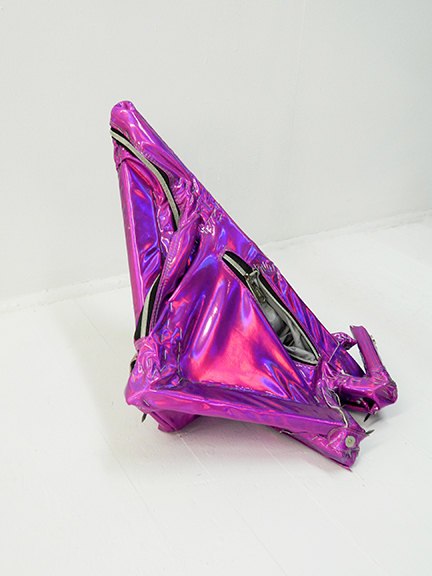
Can you walk us through the conceptual elements and technical fabrication of the Lumber Drawing series?
Deconstructing these ready-made materials (make-up brushes, bodysuits, sports bras, leggings, make-up bags, etc.) hold inherent implications of the body, perception, and space. I gravitate toward unisex colors to complicate these concepts, questioning what our expectations entail to form sculptures that are both masculine and feminine simultaneously.
The technical fabrication of the Lumber Drawing Series consists of
deconstructing said fashion elements and utilizing traditional lumber materials (i.e. lumber, staples, and screws). Low-tech materials such as a hand-saw and a drill and screws and a staple-gun are all that I utilize to make these sculptures. I don’t want to overcomplicate things so I stick to basic methods to set some limitations for myself and to work within those parameters.
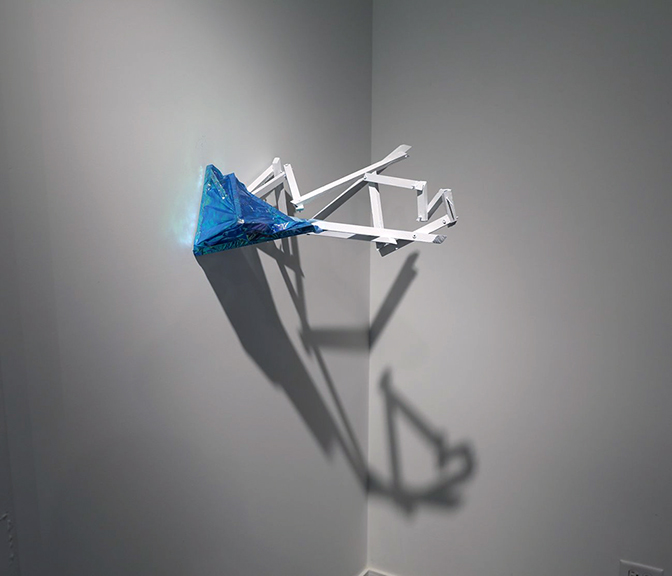
photograph by Dan Tertell
Your piece Make-up Brushes remind me of Meret Oppenheim’s Le Déjeuner en Fourrure , 1936. There is a playful absurdity in each. In yours, you assemble a handful of pink make-up brushes with what appear to be wood screws. Can you share with us your intent with this work?
Thank you! I do admire the absurdity of Oppenheim’s Le Déjeuner en Fourrure and how the piece makes you re-image simple objects in a silly and intelligent manner. I’m interested in deconstructing the ready-made via fashion elements because it references a multitude of layers including consumerism, fast fashion, and everyday appearances as well as gender expectations. The Lumber Drawing Series reference deconstructing fashion wearables, and the Make-Up Brushes (which is quickly becoming a series) is deconstructing make-up tools (i.e., brushes) with similar concepts in mind. The construction screws have the intent to reference traditional construction materials with the brushes inferring the act of application.
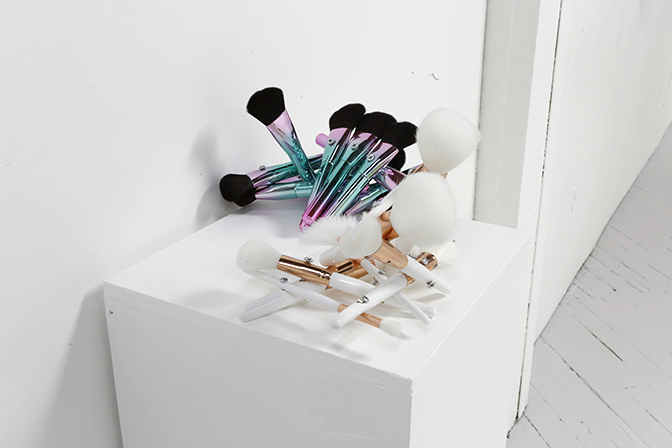
photograph by Boris Ostrerov
I notice that you sometimes use similar silhouetted forms in a couple series, (SPRAY)Paintings and If She is Abrasive It Will Condemn Her (Concrete Paintings) . These geometric outlines function in a couple ways. Firstly, I see them being an armature or unseen framework, while secondly they become a symbol. What are your thoughts?
The forms in these series were made mostly prior to (and some during) the Lumber Series. At the time, I was visualizing the structures in my mind as these were an important stepping stone before actualizing similar shapes into three-dimensional forms.
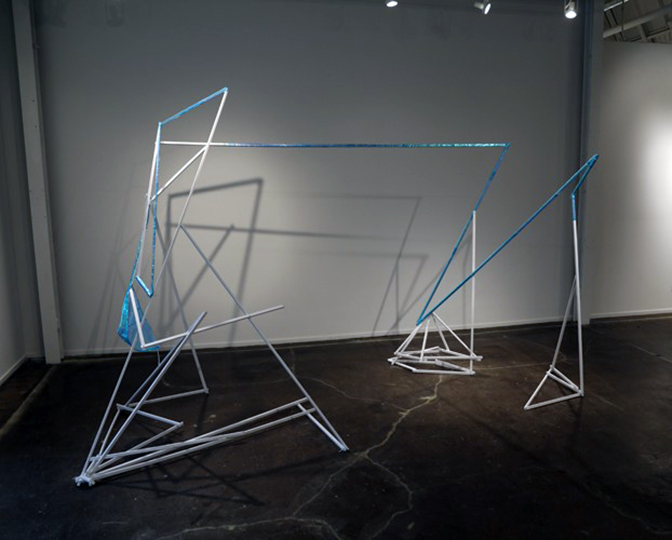
What do you value most in your aesthetic practice?
I value the freedom to explore a wide range of ideas, and the ability to play them out in my mind, even if I’m not physically in the studio. This saves me a lot of time, however I end up doing a lot of experiments anyway out of pure curiosity. I suppose my particular-ness about my aesthetics and a specific color palette has been helpful.
It can be hindering in the everyday – embarrassingly, I won’t buy
something utilitarian if I don’t like the color of it, so it’s not always a practical habit in real life, but it has been great for art stuff.
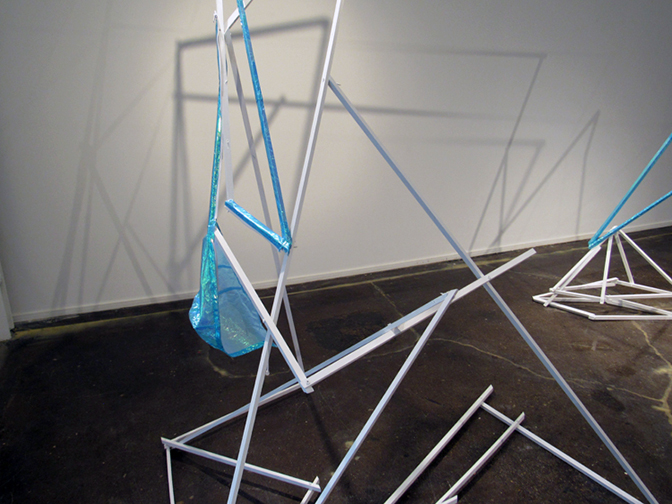
Somewhere Behind Us, Chicago, 2018, photograph by Dan Tertell
You are currently working upon the exhibit Stumble Chicago that is being curated by Jared Packard. Can you share with us what’s the focus of this exhibition? Also, do you have any additional items on the docket for the new year?
For Stumble Chicago , I’m deconstructing weather-resistant
materials, such as jackets, gloves, boots, etc. which are relevant to the unpredictable weather Chicagoans endure. These small structures are placed organically throughout our urban environment- interrupting, moving through the urban landscape such as Chicagoans do. Jackets and other outerwear are necessary to survival as well as simultaneously performing as a bonding mechanism and perhaps a socially unifying construct.
Also, at the end of March I have my second exhibition for HATCH
Projects at Chicago Artists’ Coalition as part of the year-long residency program. It’ll be a six-person group show curated by Courtney Cintron, and we’ll have some fun programming events as well. I’m constantly applying to shows & residencies and have a few other projects in the works, so stay tuned!
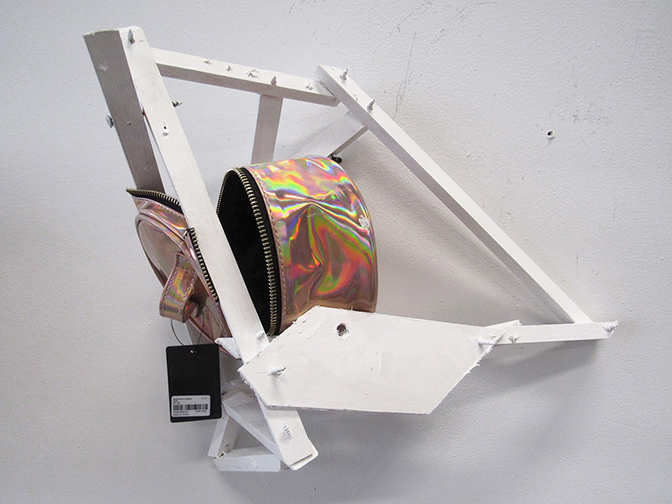
For additional information on the art practice of Erin Smego, please visit:
Erin Smego –http://colorsnob.com/
Chicago Artist Coalition – http://www.chicagoartistscoalition.org/programs/hatch-projects/2017-2018/erin-smego
Voyage Chicago – http://voyagechicago.com/interview/art-life-erin-smego
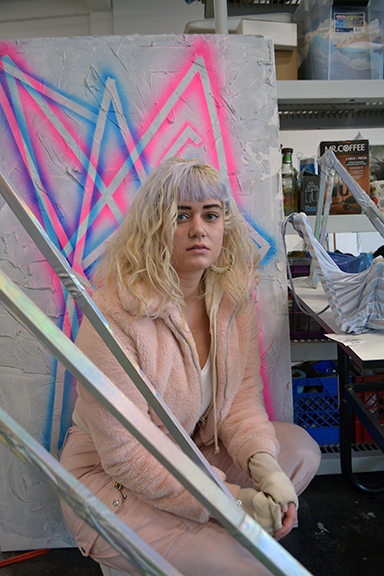
Artist interview and portrait by Chester Alamo-Costello


